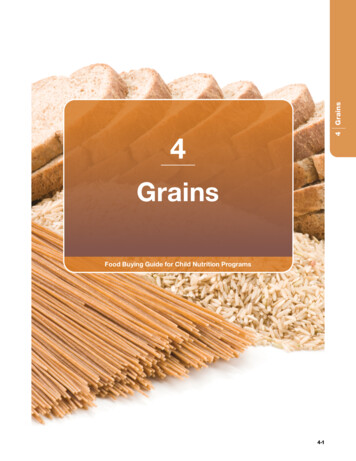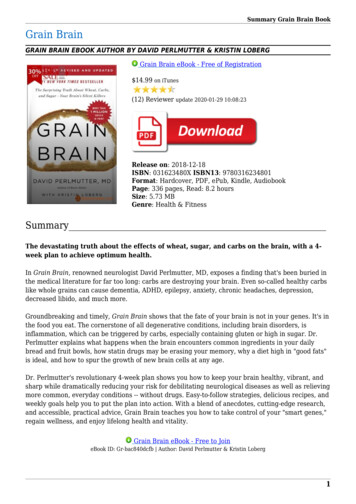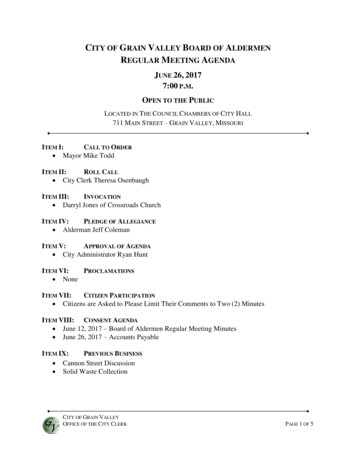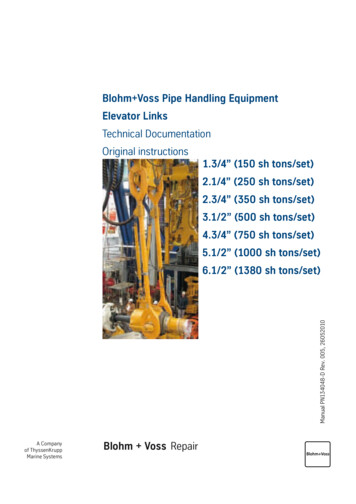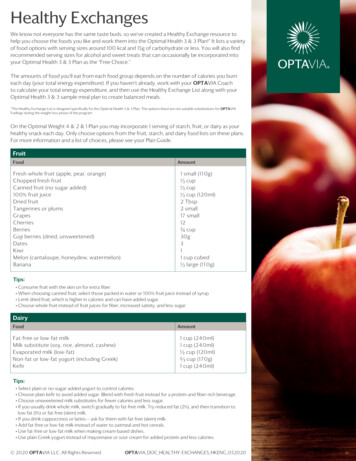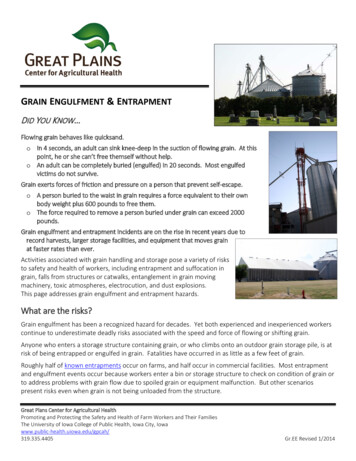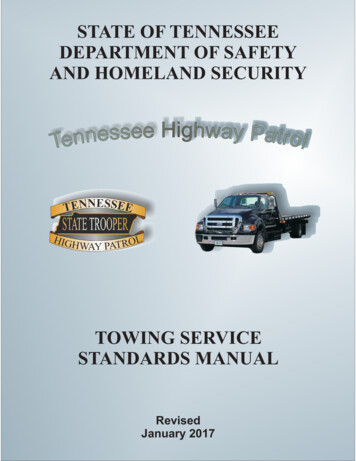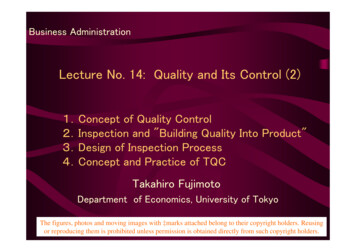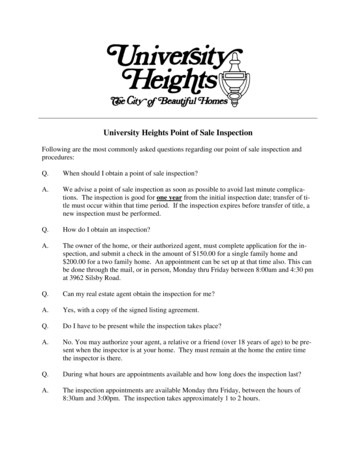
Transcription
Marketing ederal GrainInspectionServiceWashington, DCAugust 2020Grain InspectionHandbookBook IIIInspectionProcedures
United States Department of AgricultureAgricultural Marketing ServiceFederal Grain Inspection ServiceProgram HandbookAugust 28, 2020Grain Inspection Handbook – Book III Inspection ProceduresForewordBook III, Inspection Procedures, sets forth the policies and procedures relevant touniform loading and certification of lots under the Uniform Shiplot and Combined LotInspection Plan, known as the CuSum plan, in accordance with the regulations underthe United States Grain Standards Act (USGSA), as amended. The CuSum loadingplan is applicable to shiplots and unit trains.The information contained in this handbook is applicable to official grain inspectionservices performed by the Federal Grain Inspection Service (FGIS), delegated Stateagencies, and designated State and private agencies. Official inspection personnel andagricultural commodity graders licensed or authorized to inspect grain must follow theprocedures in this book when applying the CuSum loading plan.Trade names are used solely to provide specific information. The mention of tradenames does not constitute a guarantee or warranty of the product by the U.S.Department of Agriculture or an endorsement by the Department over other productsnot mentioned.In accordance with Federal civil rights law and U.S. Department of Agriculture (USDA) civil rights regulations andpolicies, the USDA, its agencies, offices, and employees and institutions participating in or administering USDAprograms are prohibited from discriminating based on race, color, national origin, religion, sex, gender identity(including gender expression), sexual orientation, disability, age, marital status, family/parental status, income derivedfrom a public assistance program, political beliefs, or reprisal or retaliation for prior civil rights activity in any programor activity conducted or funded by USDA (not all bases apply to all programs). Remedies and complaint filingdeadlines vary by program or incident.Persons with disabilities who require alternative means of communication for program information (e.g., Braille, largeprint, audiotape, American Sign Language, etc.) should contact the responsible agency or USDA’s TARGET Centerat (202) 720-2600 (voice and TTY) or contact USDA through the Federal Relay Service at (800) 877-8339.Additionally, program information may be made available in languages other than English.To file a program discrimination complaint, complete the USDA Program Discrimination Complaint Form, AD-3027,found online at How to File a Program Discrimination Complaint and at any USDA office, or write a letter addressedto USDA and provide in the letter all of the information requested in the form. To request a copy of the complaintform, call (866) 632-9992. Submit your completed form or letter to USDA by: (1) mail: U.S. Department ofAgriculture, Office of the Assistant Secretary for Civil Rights, 1400 Independence Avenue, SW, Washington, DC20250-9410; (2) fax: (202) 690-7442; or (3) email: program.intake@usda.gov.USDA is an equal opportunity provider, employer, and lender.Distribution: FGIS, OSP, Grain IndustryOriginating Office: FMD, PPMAB
TABLE OF CONTENTSCHAPTER 1: INSPECTION OF SHIPLOTS AND UNIT TRAINSCHAPTER 2: CERTIFICATION OF SHIPLOTS AND UNIT TRAINSCHAPTER 3: MATERIAL PORTION REMOVALCHAPTER 4: REVISION HISTORYAPPENDIX 1 - TOLERANCE TABLES
CHAPTER 1:INSPECTION OF SHIPLOTS AND UNIT TRAINSCONTENTS1.1INTRODUCTION . 1-41.2LOAD ORDER DOCUMENT. 1-71.3UNIFORMITY CRITERIA . 1-171.4GENERAL PROCEDURES. 1-221.5REVIEW INSPECTIONS. 1-381.6COMPONENT INSPECTIONS . 1-451.7DISPOSITION OF MATERIAL PORTIONS . 1-511.8DETERMINING MATHEMATICAL OR WEIGHTED AVERAGE . 1-541.9FINAL GRADE . 1-571.10CUSUM CUTOFF REQUESTS. 1-58TABLE 1.1 – SUBLOT RESTRICTIONS . 1-9TABLE 1.2 – LIMITS FOR GRAIN TYPES WITH CLASS AS GRADING FACTOR . 1-12TABLE 1.3 – LOTS LOADED WITH SUBLOT FACTOR ANALYSIS . 1-17TABLE 1.4 – LOTS LOADED WITH COMPONENT FACTOR ANALYSIS . 1-18TABLE 1.5 – RECORDING CUSUM VALUES . 1-29FIGURE 1.1 – INSPECTION LOG FACTOR COLUMN . 1-22FIGURE 1.2 – RECORDING GRADE LIMITS, BREAKPOINTS, ANDSTARTING VALUES ON THE INSPECTION LOG:HANDWRITTEN EXAMPLE . 1-23FIGURE 1.3 – RECORDING GRADE LIMITS, BREAKPOINTS, ANDSTARTING VALUES ON THE INSPECTION LOG:ITW CUSUM APPLICATION EXAMPLE . 1-24Grain Inspection HandbookChapter 1: Inspection of Shiplots andUnit TrainsAugust 2020Book III Inspection Procedures1-1
FIGURE 1.4 – RECORDING SUBLOT FACTOR RESULTSON THE INSPECTION LOG:HANDWRITTEN EXAMPLE . 1-27FIGURE 1.5 – RECORDING SUBLOT FACTOR RESULTSON THE INSPECTION LOG:ITW CUSUM APPLICATION EXAMPLE . 1-28FIGURE 1.6 – RECORDING CUSUM VALUES FOR FIRST SUBLOT:HANDWRITTEN EXAMPLE . 1-31FIGURE 1.7 – RECORDING CUSUM VALUES FOR FIRST SUBLOT:ITW APPLICATION EXAMPLE . 1-31FIGURE 1.8 – RECORDING CUSUM VALUES FOR SUBSEQUENT SUBLOTS:HANDWRITTEN EXAMPLE . 1-32FIGURE 1.9 – RECORDING CUSUM VALUES FOR SUBSEQUENT SUBLOTS:ITW APPLICATION EXAMPLE . 1-32FIGURE 1.10 – INPSECTION LOG SHOWING BEAKPOINT VIOLATION:HANDWRITTEN EXAMPLE . 1-34FIGURE 1.11 – INSPECTION LOG SHOWING BREAKPOINT VIOLATION:ITW APPLICATION EXAMPLE . 1-34FIGURE 1.12 - RESETTING THE CUSUM VALUE TO THE BREAKPOINT:HANDWRITTEN EXAMPLE . 1-35FIGURE 1.13 – RESETTING THE CUSUM VALUE TO THE BREAKPOINT:ITW APPLICATION EXAMPLE . 1-35FIGURE 1.14 – SUBLOT FOLLOWING A MATERIAL PORTION:HANDWRITTEN EXAMPLE . 1-36FIGURE 1.15 – SUBLOT FOLLOWING A MATERIAL PORTION:ITW APPLICATION EXAMPLE . 1-36FIGURE 1.16 – RECORDING REVIEW INSPECTION RESULTS ON THEINSPECTION LOG: HANDWRITTEN EXAMPLE . 1-41FIGURE 1.17 – RECORDING REVIEW INSPECTION RESULTSON THE INSPECTION LOG:ITW APPLICATION EXAMPLE . 1-42FIGURE 1.18 – RECORDING CUSUM VALUES WHEN A MATERIAL PORTIONIS LOADED TO ANOTHER LOT . 1-52Grain Inspection HandbookChapter 1: Inspection of Shiplots andUnit TrainsAugust 2020Book III Inspection Procedures1-2
FIGURE 1.19 – EXAMPLE OF RECEIVING LOT . 1-52FIGURE 1.20 – “CUTOFF” REQUEST TO BE DENIED . 1-58ATTACHMENT 1: EXAMPLE – INSPECTION LOG (MANUAL/HANDWRITTEN) . 1-59ATTACHMENT 2: EXAMPLE – INSPECTION LOG (ITW CUSUM APPLICATION) . 1-60Grain Inspection HandbookChapter 1: Inspection of Shiplots andUnit TrainsAugust 2020Book III Inspection Procedures1-3
1.1INTRODUCTIONa.This chapter establishes procedures for official personnel inspecting bulkgrain loaded or unloaded from ships and unit trains as single lots inaccordance with Section 800.86 of the regulations under the United StatesGrain Standards Act (USGSA). Sacked grain is inspected according toprocedures found in FGIS Directive 9180.41, “Sacked Grain.” Sackedgrain lots inspected online (inspected prior to or during the sackingoperation) are inspected according to the procedures in this chapter.b.The CuSum plan, set forth in this chapter, represents an onlineacceptance sampling plan that provides continuous quality informationwith the objective of obtaining a consistent minimum quality throughout thelot. This is achieved by using statistically based tolerances which acceptoccasional portions of a lot that, due to known sampling and gradingvariations, may grade below the desired lot quality. There is no limit to theamount of higher quality grain permitted in a lot.c.The grade of a lot informs the buyer of the overall or average quality of alot. The applicant for inspection indicates the contracted lot quality in aload order document submitted to inspection personnel prior to loading.Although the grade on portions of a lot may fluctuate above or below theindicated grade, the average quality of all factors in the certified lot mustmeet or be of better quality than that stated in the load order documentonce loading or unloading is completed.d.The inspection process requires continuous sampling during loading orunloading. Grain is sampled and accumulated in a systematic process forexamination.Grain Inspection HandbookChapter 1: Inspection of Shiplots andUnit TrainsAugust 2020Book III Inspection Procedures1-4
(1)Ship Sampling. Ship sublot samples are composed of multiplecomponent and subsamples.Note: When component ship sample analysis is requested onone or more factors, the maximum sublot size increases to upto 200,000 bushels.(2)Unit Train Sampling. Unit train sublot samples are composed ofmultiple component samples.Grain Inspection HandbookChapter 1: Inspection of Shiplots andUnit TrainsAugust 2020Book III Inspection Procedures1-5
e.Each subsample, component sample, and sublot sample is analyzed forspecific quality criteria in accordance with the Official U.S. Standards forGrain and the sales contract. Any grain not meeting required qualitylevels is declared a “material portion.” The applicant will then have anoption to either remove the material portion from the lot or leave thematerial portion on board and request a separate certificate. Thecomponent samples not designated as a “material portion” are thencombined with other uniform component samples to form a sublot.f.All grain conforming to CuSum requirements is certified as a single lotbased on the combined average of the sublot results.g.FGISonline provides the Inspection, Testing, and Weighing (ITW)application for automatic calculation of CuSum values and lot averages,which FGIS personnel use to record all shiplot inspections. Officialpersonnel employed by delegated State agencies, or designated Stateand private agencies, may use the ITW application, FGIS-921, or anequivalent application of their choosing.Grain Inspection HandbookChapter 1: Inspection of Shiplots andUnit TrainsAugust 2020Book III Inspection Procedures1-6
1.2LOAD ORDER DOCUMENTa.General. Prior to loading or unloading and before inspection can begin,the applicant for inspection must provide a load order document to officialpersonnel, reflecting contract requirements for quality and quantity. Theindividual issuing the load order must sign the document.The load order document must reflect the same quality and conditionfactors contained in the sales contract. Specifically, the document mustdeclare the following:(1)The exact grade and the percent moisture and dockage, whenapplicable.(2)Details on CuSum or Average Quality factors.(a)If the lot is based on average quality, state the term“Average” after the grade to be loaded (e.g., U.S. No. 2 orbetter YSB – Average).(b)If average on most factors and minimum and/or maximum onselect factors, state the grade accordingly (e.g., U.S. No. 2or better YSB – Average except Moisture maximum 13.0percent, Foreign Material maximum 2.0 percent).(c)If minimum and/or maximum (CuSum) on most factors andaverage on select factors, state the grade accordingly (e.g.,U.S. No. 2 or better YSB – CuSum except Moisture average13.0 percent, Foreign Material average 2.0 percent).To express a minimum and/or maximum factor requested at thegrade or specified limit per sublot, the applicant should state theterm “No sublot to exceed” with “Minimum” or “Maximum” after thegrade to be loaded or after a specific factor (e.g., U.S. No. 2 orbetter YSB – No sublot to exceed maximum 1.0 percent FM; orU.S. No. 2 or better YSB - No sublot to exceed, all factors minimumor maximum per sublot). “No sublot to exceed” is not applicable toAverage Quality.Note: CuSum values will not be applied to factors requestedon an Average Quality or “No sublot to exceed” basis.(3)The approximate quantity of grain in the lot.(4)The sublot size.Grain Inspection HandbookChapter 1: Inspection of Shiplots andUnit TrainsAugust 2020Book III Inspection Procedures1-7
(5)The destination.(6)“Option 1” or “Option 2” certification, or the term “or better.”(7)Any official criteria (e.g., protein, oil, starch, mycotoxins, fallingnumber), lower limits on sample grade or special grade factors(e.g., free from stones, ergot, or insects), or other maximum orminimum limits for factor determinations. For wheat, include anyspecific insect damaged kernels (IDK) information as applicable,such as a maximum IDK count per sublot (other than the FDAacceptable limit of 31), any special instructions to inspect 100grams per sublot, and IDK certification requirements.(8)Any alternative reporting requirements; such as alternative moisturebasis for protein, oil, starch, or falling number or increasedprecision for certain factors (e.g., DON reported to tenth ppm).(9)Any other specific requirements needed to fulfill contractrequirements.If a load order document is confusing as to the request, official personnelmust return the load order document to the applicant for an explanationand/or correction.A load order grade is not required prior to loading if the applicant does notknow the exact grade to be loaded or plans to load grain of differentquality without cutoffs or separations (i.e., barge-to-ship operations).When a load order grade is not declared, certify the lot to the best, uniformgrade. If the lot is not uniform for any grade, combine the sublots of thesame grade and certify them together as individual lots. Certificationrequirements are discussed in Chapter 2, Certification of Shiplots and UnitTrains.The applicant may change load order requirements after official personnelreceive a load order, provided the contract was amended to reflect thenew requirements. When a contract is amended, a revised load orderdocument is required. Official personnel may request a copy of theamended contract or confirmation of sale as verification if a load orderrequirement is revised after loading begins.b.Establishing Sublot Size. The size of the sublot determines the frequencyat which inspection personnel examine sublot samples. The number andsize of sublots in a lot are dependent on certain restrictions (see Table 1.1– Sublot Restrictions). The applicant may establish the sublot size bestsuited for the size of the lot, quality control of the elevator, and efficiencyof inspection. Sublot restrictions are listed in the adjoining table.Grain Inspection HandbookChapter 1: Inspection of Shiplots andUnit TrainsAugust 2020Book III Inspection Procedures1-8
Applicants may not request a change to the sublot size once the sublotsize is established and loading begins.TABLE 1.1 – SUBLOT RESTRICTIONSCarrierMinimum Number of Maximum Size ofSublotsEach SublotLot SizeVesselsUnit Trains100,000 bushels or less1----------100,000 to 200,000 bushels2100,000 bushelsOver 200,000 bushels3100,000 bushels125 cars510 carsLess than 200,000 bushels(Less than 50 cars)200,000 bushels or more (50cars or more)1200,000 bushels when component sample analysis is requested on one or more factors.(1)All sublots loaded, except for the last sublot in the lot, must be“reasonably uniform in size.” That is, the largest sized sublotloaded may not be more than 25 percent larger than the smallestsublot. To determine the allowable variation in size, multiply thesmallest size sublot by 1.25. The resulting figure is the maximumsublot size.For Example:If the smallest size sublot is 40,000 bushels,then the maximum sublot size would be 50,000bushels.40,000 x 1.25 50,000(2)The last sublot may not amount to less than 5 percent of theaverage size of the sublots in the lot, unless after the final sublot isloaded aboard, the National Cargo Bureau (NCB) surveyor, portsurveyor, stevedoring personnel, ship’s captain, or other personresponsible for the security of the vessel indicates that more grainmust be loaded for vessel security. Consider the additional amountordered the last sublot and grade accordingly.(3)The last sublot in a unit train may not be more than one car largerthan the maximum sublot size allowed for the size of train.Grain Inspection HandbookChapter 1: Inspection of Shiplots andUnit TrainsAugust 2020Book III Inspection Procedures1-9
c.d.Electing the Certification Option. Option 1 and Option 2 are both methodsof certifying the grade of a lot. Under Option 1, the exact grade of thegrain is shown on the certificate. Under Option 2, the lot is certified asbeing equal to or better than the grade specified by the contract.(1)The applicant for inspection must select the certification option andindicate this choice on the load order document. Option 2certification is used if the load order specifies “or better” as part ofthe load order grade, or if Option 2 is specifically requested.(2)The applicant may change the certification option at a later time,provided the certificates have not been issued or corrected, thencertificates are issued to reflect the new certification option.Declaring the Grade to be Loaded. The applicant should use the followingguidelines when declaring the grade to be loaded:(1)Declare the numerical grade consistent with the lowest qualityfactor limit established for the lot.For Example:A contract is signed for a shipment of U.S. No.2 Dark Northern and/or Northern SpringWheat. The applicant requests certificationunder Option 2.State the load order grade as: “U.S. No. 2 orbetter Northern Spring Wheat.”(2)Include the phrase “or better” immediately following the numericalor Sample grade designation for Option 2 certification. The “orbetter” designation is applicable to all numerical (except U.S. No. 1)and Sample Grades, subclasses (except Soft White Wheatsubclasses), special grades, special factor requirements, dockage,class in Mixed Wheat, Mixed Corn, Mixed Sorghum, MixedSoybeans, and Mixed Grain.Grain Inspection HandbookChapter 1: Inspection of Shiplots andUnit TrainsAugust 2020Book III Inspection Procedures1-10
(3)Include any special factor requirements that are more stringent thanthe declared numerical grade. Adjust the numerical gradedesignation on the load order document to correspond to thespecial factor requirements if special factor requirements are of alower quality than the contracted numerical grade.For Example:The contract stipulates U.S. No. 2 or betterYellow Soybeans, maximum 4.0 percentforeign material (FM).State the load order grade as: “U.S. No. 4 orbetter Yellow Soybeans, maximum 4.0 percentFM, all other factors U.S. No. 2 YellowSoybeans.”Note: Special factor limits are used in determining uniformitybut are not shown on the grade line of an official certificate.e.(4)Request average quality or “No sublot to exceed” when applicable.(5)Declare any other official inspection or testing requirements neededto fulfill the sales contract (e.g., max 15 IDK; minimum protein 12.5percent).Interpretation of Load Order Specifications. Official personnel should usethe following guidelines:(1)Maximum and Minimum Limits. Load orders generally specifymaximum or minimum limits as quality criteria. Inspection plantolerances are applied to a specific factor if the load order indicatesa maximum or minimum limit. Factors that do not have tolerances(e.g., sprout damage) must meet contract specifications for eachsublot unless specifically designated otherwise (e.g., soybean oiland protein).Treat load orders which specify a quality limit without the term“maximum” or “minimum” as a maximum for factors havingmaximum limits (e.g., damaged kernels total (DKT), foreignmaterial, moisture (M)), or as a minimum for factors havingminimum limits (e.g., test weight per bushel, sound barley).Applicants must indicate on the load order wheat protein as amaximum, minimum, or average amount if a specific wheat proteinlevel is shown on the load order. Consider wheat proteinexpressed as “ordinary” as an average.Grain Inspection HandbookChapter 1: Inspection of Shiplots andUnit TrainsAugust 2020Book III Inspection Procedures1-11
(2)Average Quality. Do not use CuSum tolerances on sublot resultswhen average quality certification is requested. The load ordermust indicate “average,” “average not more/less than,” or “averagenot to exceed” if an applicant wants certification of average qualitywhen a specific percentage or count is declared.Average quality is part of the CuSum loading plan and adheres tothe basic CuSum rules (e.g., combining acceptable componentsamples in the order that sampling was completed to form a sublot,etc.). “Average” grade may be applied to grade factors, moisture,and official criteria factors, but does not apply to odor and condition.It also does not apply to aflatoxin test results that are above theFDA action limit of 20 ppb. Aflatoxin results above 20 ppb may notbe averaged with results at or below 20 ppb.Average quality is not applicable to class, except for grains whereclass is a grading factor (see Table 1.2 – Limits for Grain Typeswith Class as Grading Factor), subclass, sample grade factors orspecial grade factors, or grain where class is a grading factor,average quality is allowed, but each sublot must meet the classrequirements for the grain type. Breakpoints and starting values donot apply. Any sublot not meeting class requirements is declared amaterial portion.When “average” factor result inspection is requested, it is theloading elevator’s responsibility to meet the quality level specified inthe contract. The final inspection certificate for “average” factors isbased on the final factor average. Do not show statements of“average” factor range results or which factor(s) were requested onan “average” basis on the certificate unless specifically requested.Additionally, certify the average quality of a factor when a specificpercentage is not declared on the load order (e.g., undeclareddockage, undeclared moisture) or wheat protein is expressed as“ordinary.”TABLE 1.2 – LIMITS FOR GRAIN TYPES WITH CLASS AS GRADING FACTORGrading FactorMinimum/MaximumAllowed per SublotWheat – WOCL/CCLMaximum 10.4 percentSoybeans – SBOCMaximum 10.0 percentMalting Barley – SMTMinimum 95.0 percentGrain Inspection HandbookChapter 1: Inspection of Shiplots andUnit TrainsAugust 2020Book III Inspection Procedures1-12
(3)Interpreting an Average Quality Load Order.(a)“Average”. If a load order stipulates U.S. No. 2 or betterYSB (average), interpret that as a request for an average ofall grading factors. Set up all grading factors except SBOCas average quality. Set the SBOC grade limit to a maximumof 10.0 percent, do not apply a breakpoint and starting value.(b)“Average” Select Factors. If the load order states U.S. No. 2or better YSB, maximum 1.5 Foreign Material (FM), all otherfactors “average,” interpret the request as CuSum applied toFM only, and “average” for Test Weight (TW), Moisture,Damaged Kernels Total, Heat Damage, and Splits.Soybeans of Other Colors are limited to a maximum of 10.0percent per sublot.For Example:U.S. No. 2 or better Yellow Soybeans(Average):Average 13.5 percent moistureAverage minimum TW 55.0 lbs.Responsibility of FGIS. Set up a log with the applicablegrade factor limits for U.S. No. 2 Yellow Soybeans with amoisture content of 13.5 percent and a SBOC grade limit setat a maximum of 10.0 percent per sublot. Indicate on the log that the grading factors, testweight and moisture are based on “average” quality.Note: Do not complete starting value orbreakpoint blocks on log.Shipper’s Responsibility. Maintain a final grade average ofU.S. No. 2 or better Yellow Soybeans with 13.5 percent orless moisture. (4)Maintain any self-imposed limits.Range Limits. Some load orders specify a minimum limit as well asa maximum limit for factors to establish an acceptable range.Inspection plan tolerances are applied to both the minimum andmaximum limits. In this case, use two factor columns for the singlefactor. One column is for the minimum limit and the other column isfor the maximum limit. CuSum values are calculated for eachcolumn based on the inspection results.Grain Inspection HandbookChapter 1: Inspection of Shiplots andUnit TrainsAugust 2020Book III Inspection Procedures1-13
(5)“No Sublot to Exceed” Limits. Some load orders indicate thatcertain factors must be within a specified limit per sublot. If anapplicant indicates this type of request on the load order, do notapply tolerances to the factor(s). A material portion occurs if thespecific factor(s) exceeds the load order limit. This provisionapplies to sublot results but not to component sample results.(6)Dockage. The applicant is responsible for specifying the limit, ifany, for dockage on the load order. If no maximum dockage isspecified, interpret dockage as an average quality factor.(7)Special Factor Requirements. Some load orders contain factorlimitations that are not at the numerical grade limit. For example, acontract for U.S. No. 2 Yellow Soybeans may contain a clauselimiting the amount of foreign material (FM) to a maximum of 1.5percent. The grade limit for foreign material in U.S. No. 2 YellowSoybeans is 2.0 percent. Any special factor requirements stated inthe load order are considered the allowable grade limit for the lot.In the above example, 1.5 percent is the allowable limit for foreignmaterial.(a)To apply the uniformity criteria for the inspection plan,establish both the “more than one numerical grade” limit anda “breakpoint” limit. Use the “more than one grade” limit todetermine uniformity between component samples (seesection 1.3(b)). Use the breakpoint limit to establishuniformity for sublot samples (see section 1.3(c)).(b)Compute the “more than one grade” limit by determining thedifference between the numerical grade encompassing thespecial factor limit and the next inferior grade and adding thisdifference to the special factor limit. For instance, a loadorder grade of U.S. No. 2 Yellow Soybeans with a maximumof 1.5 percent foreign material is requested. The 1.5 percentforeign material is within the U.S. No. 2 grade limit. Thedifference between the foreign material grade limit for U.S.No. 2 (2.0 percent) and U.S. No. 3 (3.0 percent) is 1.0percent. Add the 1.0 percent to the allowable limit, whichyields the “more than one grade” limit of 2.5 percent.Grain Inspection HandbookChapter 1: Inspection of Shiplots andUnit TrainsAugust 2020Book III Inspection Procedures1-14
(c)(8)The breakpoint for the grade factor is the same as that of thenumerical grade that encompasses the factor limit. Usingthe same example, 1.5 percent foreign material is within thegrade limit for U.S. No. 2 Yellow Soybeans. The breakpointfor foreign material in U.S. No. 2 Yellow Soybeans is 0.3.Thus, the breakpoint for the special grade of 1.5 percentforeign material is also 0.3.Metric Test Weight Requirements. Some contracts contain graindensity requirements expressed as a minimum amount in kilogramsper hectoliter (kg/hL). For example, a contract for U.S. No. 2 orbetter Hard Red Winter Wheat may contain a clause that restrictsthe grain density to a minimum of 76 kg/hL. In this example, 76kg/hL (or its pounds per bushel equivalent) is the allowable limit forgrain density or test weight per bushel (TW). The correspondingTW is 57.7 lbs (see example below).Note: Official personnel may use the formulas listed below tomake the appropriate conversions, or refer to Appendix 2,“Test Weight/Kilograms Per Hectoliter Conversion Charts forWheat and Other Grains” of Grain Inspection Handbook, BookII - Grading.Grain Inspection HandbookChapter 1: Inspection of Shiplots andUnit TrainsAugust 2020Book III Inspection Procedures1-15
(a)To apply the uniformity criteria for the inspection plan,convert the metric bulk density (MBD) in kg/hL to test weightin pounds per bushel (lbs/bu) using the following applicableformula:Durum WheatOther WheatOther GrainsFor Example:(b)TW (76 - 1.419) 1.292TW (74.58 1.292)TW 57.725 lbs/buRounded minimum limit 57.7 lbsShow the average test weight (pounds per bushel) result onthe final certificate using approved rounding and reportingprocedures. Report the metric equivalent in the “REMARKS”section of the certificate, based on the average test weightper bushel value before rounding. Use the followingconversion formula to determine the MBD to be shown in thecertificate “REMARKS” section.Durum WheatOther WheatOther Grains(c)TW (MBD – 0.630) 1.292TW (MBD – 1.419) 1.292TW MBD 1.287MBD (TW x 1.292) 0.630MBD (TW – 1.292) 1.419MBD TW x 1.287The ITW CuSum application will automatically calculate thekilograms per hectoliter for each sublot and convert theaverage test weight per bushel value
Grain Inspection Handbook - Book III Inspection Procedures Foreword Book III, Inspection Procedures, sets forth the policies and procedures relevant to uniform loading and certification of lots under the Uniform Shiplot and Combined Lot Inspection Plan, known as the CuSum plan, in accordance with the regulations under
